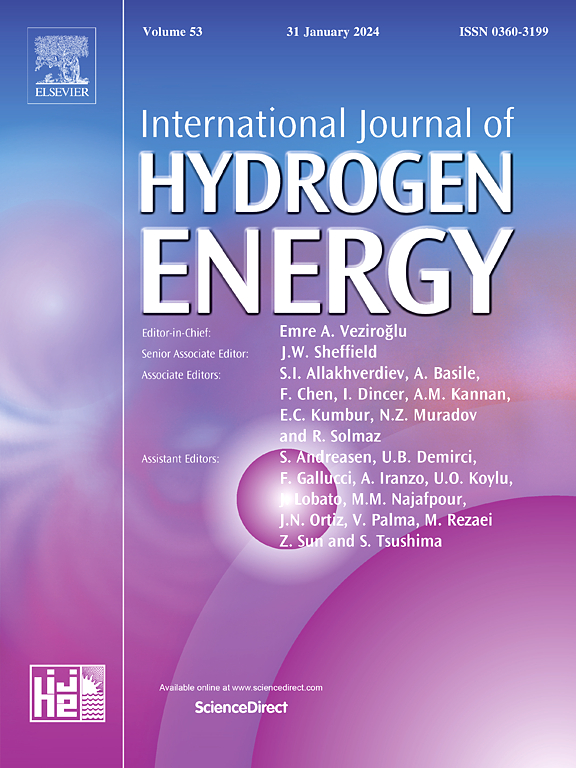zif衍生的三维碳纳米片/纳米管框架,封装CoNi纳米颗粒,用于高效LOHC储氢
IF 8.1
2区 工程技术
Q1 CHEMISTRY, PHYSICAL
引用次数: 0
摘要
液态有机氢载体(LOHC)系统需要高效、低成本的催化剂来实现可扩展的储氢。本研究通过一步还原热解ZIF-67-L制备了可重复使用的CoNi双金属催化剂,形成了嵌套在三维碳纳米片/纳米管(CNS/CNT)异质结构中的CoNi合金纳米颗粒。以n -乙基咔唑(NEC)为模型化合物,优化后的催化剂可实现快速加氢(在150°C、8 MPa、80 min条件下吸附5.72 wt% H2)和脱氢(在220°C、0.1 MPa条件下释放5.64 wt% H2),并具有7个循环的高可回收性。CNS/CNT促进电子传递,增强活性位点暴露,并提供高表面积。结合XPS和DFT结果表明,CNS/CNT结构和CoNi合金之间的协同作用调节了Co0位点的电子环境,降低了H2解离的能量势垒,提高了催化性能。该研究为LOHC系统设计高活性、稳定的非贵金属催化剂以实现可逆储氢提供了新的思路。本文章由计算机程序翻译,如有差异,请以英文原文为准。

ZIF-derived 3D carbon nanosheet/nanotube framework with encapsulated CoNi nanoparticles for efficient LOHC hydrogen storage
Liquid organic hydrogen carrier (LOHC) systems require efficient, low-cost catalysts for scalable hydrogen storage. Here, a reusable CoNi bimetallic catalyst was developed through one-step reductive pyrolysis of ZIF-67-L, forming CoNi alloy nanoparticles embedded in a 3D carbon nanosheet/nanotube (CNS/CNT) heterostructure. Using N-ethylcarbazole (NEC) as a model compound, the optimized catalyst enables rapid hydrogenation (5.72 wt% H2 uptake at 150 °C, 8 MPa in 80 min) and dehydrogenation (5.64 wt% H2 release at 220 °C, 0.1 MPa), with high recyclability over seven cycles. The CNS/CNT facilitates electron transport, enhances active site exposure, and provides a high surface area. Combined XPS and DFT results reveal that the synergy between the CNS/CNT architecture and CoNi alloying modulates the electronic environment of Co0 sites, reduces the energy barrier for H2 dissociation, and improves catalytic performance. This study provides new insights into the design of highly active and stable non-noble metal catalysts for LOHC systems to achieve reversible hydrogen storage.
求助全文
通过发布文献求助,成功后即可免费获取论文全文。
去求助
来源期刊

International Journal of Hydrogen Energy
工程技术-环境科学
CiteScore
13.50
自引率
25.00%
发文量
3502
审稿时长
60 days
期刊介绍:
The objective of the International Journal of Hydrogen Energy is to facilitate the exchange of new ideas, technological advancements, and research findings in the field of Hydrogen Energy among scientists and engineers worldwide. This journal showcases original research, both analytical and experimental, covering various aspects of Hydrogen Energy. These include production, storage, transmission, utilization, enabling technologies, environmental impact, economic considerations, and global perspectives on hydrogen and its carriers such as NH3, CH4, alcohols, etc.
The utilization aspect encompasses various methods such as thermochemical (combustion), photochemical, electrochemical (fuel cells), and nuclear conversion of hydrogen, hydrogen isotopes, and hydrogen carriers into thermal, mechanical, and electrical energies. The applications of these energies can be found in transportation (including aerospace), industrial, commercial, and residential sectors.
 求助内容:
求助内容: 应助结果提醒方式:
应助结果提醒方式:


